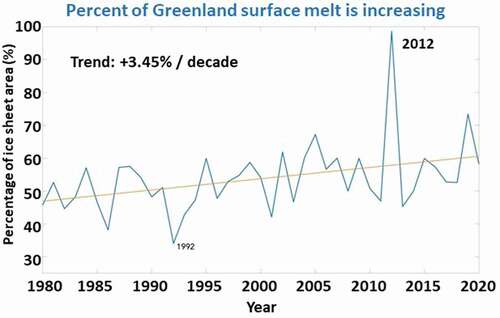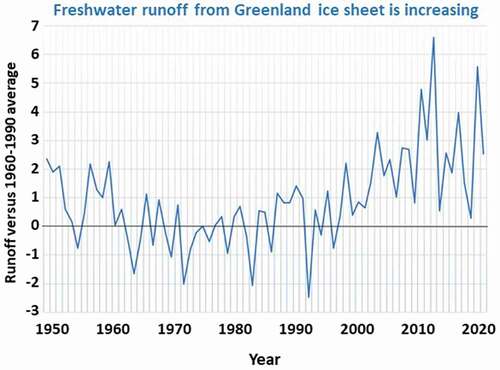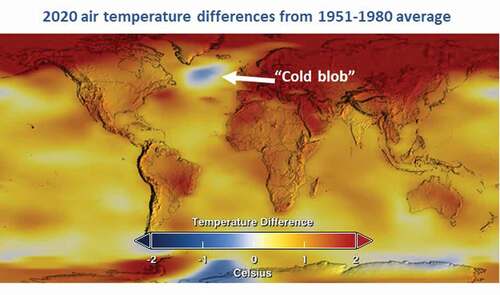THE ISSUE
Greenland’s ice sheet is melting at an accelerating pace, augmenting sea-level rise and altering ocean currents and weather patterns in the Atlantic and beyond.
WHY IT MATTERS
In only a few decades, half of the summertime Arctic sea ice coverage has disappeared, an area equal to that of the United States east of the Mississippi. During the same period, Greenland’s ice sheet has experienced vastly increased areas of surface melting during summer, adding several hundred billion tons of meltwater to the ocean and directly contributing to sea level rise, a growing threat for coastal communities and ecosystems world-wideCitation1. Human-induced global warming is the main driver of sea-ice loss, and peak years for Greenland summer melting coincide with years of greater sea ice loss. Current research suggests that disappearing sea ice and disproportionate Arctic warming contribute to accelerated Greenland melt, which is now the single largest driver of sea-level riseCitation1,Citation2
STATE OF KNOWLEDGE
In a typical year before 2000, about 30–40 percent of Greenland’s surface experienced melt (). Since 2000, that area has steadily increased, with new records set in 2002, 2007, 2010, and in 2012 the melt coverage jumped to an astonishing 97 percent. The summer of 2019 also had a very large area of meltCitation3.
Figure 1. Maximum area of Greenland that experienced surface melt, 1979–2020 (Courtesy: M. Tedesco).

A key culprit in causing these extreme Greenland melt seasons is a prolonged north-flowing wind pattern that brings warm, moist air over the ice sheet. These wind patterns are usually associated with an atmospheric “blocking high,” in which upper-level winds spin in a separated loop of circulating airCitation4. As the name suggests, these blocks tend to prevent weather systems from progressing eastward as they normally would. By creating a persistent weather pattern, a prolonged period of warm, moist southerly winds can cause major melt events on the surface of the Greenland ice sheet.
New research suggests that atmospheric blocks are occurring more often, especially in the Atlantic region in summer. While the causes of this trend are still under investigation, sea-ice loss appears to be a crucial factorCitation4. In years of substantially reduced sea ice, the resulting surface warming favors large northward swings in the upper-level winds that can lead to blocking and cause a northward transport of heat and moisture that enhance melt on Greenland’s surface. If the sea-ice cover continues to decline and blocking events occur more frequently, the extent and duration of Greenland melt should increase further ().
Figure 2. Meltwater runoff between 1950 and 2020 (relative to mean from 1960 to 1990) accumulated over the ice sheet, as simulated by an atmospheric regional model (MAR). (Courtesy: M. Tedesco).

Increased freshwater runoff from Greenland has additional significant consequences. A large area of unusually fresh ocean water has formed southeast of Greenland in the past few years, and recent studies have linked it to the extra Greenland runoff as well as to increased freshwater from the Arctic Ocean owing to more rapid springtime snowmelt on landCitation5,Citation6. Fresher water is less dense, thus it resists mixing with the underlying warmer ocean. Through this reduced mixing, the freshening is believed to be slowing the major current system of the Atlantic as well as creating a pronounced cool area to the south of Iceland that consistently shows up in maps of annual temperature anomalies, otherwise dominated by warming (). This “cool blob” of ocean temperatures may be affecting the strength and location of the Atlantic storm track, creating unusual conditions in Europe (e.g., more frequent storms and flooding)Citation6.
Figure 3. Near-surface temperature differences (in oC) for 2020 relative to average from 1951–1980. Figure from NASA at https://svs.gsfc.nasa.gov/4882.

WHERE THE RESEARCH IS HEADED
Research is focusing on better observing, understanding, and predicting the effects of sea-ice ice loss and unprecedented rates of Arctic warming on the Greenland ice sheet, sea-level rise, and other impacts within and beyond the Arctic. While progress is rapid, the climate system is a complex web of interconnected forces and consequences. The links in the chain described above are consistent with basic laws of physics and with our understanding of the climate system, but the rapidly changing Arctic will undoubtedly present new puzzles and surprises. The effects of less and less sea ice in the Arctic Ocean, along with earlier spring snowmelt across North America and Eurasia, are bound to be substantial – huge areas of the north that used to remain white for most of the year are now dark ocean or exposed land for far longer, changing the Earth’s energy balance in profound ways. Runoff from Greenland is now at a scale where, among other things, impacts on large-scale ocean currents are likely and may already be occurringCitation6.
Supplemental Material
Download MS Word (185.7 KB)Supplementary material
Supplemental material for this article can be accessed on the publisher’s website
Additional information
Funding
Key references
- Caesar, L., G. D. McCarthy, D. J. R. Thornalley, N. Cahill, and S. Rahmstorf. 2021. Current Atlantic meridional overturning circulation weakest in last millennium. Nature Geoscience 14:118–20. doi:https://doi.org/10.1038/s41561-021-00699-z.
- Keil, P., T. Mauritsen, J. Jungclaus, C. Hedemann, D. Olonscheck, and R. Ghosh. 2020. Multiple drivers of the North Atlantic warming hole. Nature Climate Change 10:667–71. doi:https://doi.org/10.1038/s41558-020-0819-8.
- Moon, T. A., M. Tedesco, J. E. Box, J. Cappelen, R. S. Fausto, X. Fettweis, N. J. Korsgaard, et al. 2020. Greenland ice sheet. Arctic Report Card 2020. doi:https://doi.org/10.25923/ms78-g612.
- Sasgen, I., B. Wouters, A. S. Gardner, M. D. King, M. Tedesco, F. W. Landerer, C. Dahle, H. Save, and X. Fettweis. 2020. Return to rapid ice loss in Greenland and record loss in 2019 detected by the GRACE-FO satellites. Communications Earth & Environment 1 (1):1–8. doi:https://doi.org/10.1038/s43247-020-0010-1.
- Stroeve, J. C., J. R. Mioduszewski, A. Rennermalm, L. N. Boisvert, M. Tedesco, and D. Robinson. 2017. Investigating the local-scale influence of sea ice on Greenland surface melt. The Cryosphere 11:2363–81. doi:https://doi.org/10.5194/tc-11-2363-2017.
- Tedesco, M., T. Mote, X. Fettweis, E. Hanna, J. Jeyaratnam, J. F. Booth, R. Datta, and K. Briggs. 2016. Arctic cut-off high drives the poleward shift of a new Greenland melting record. Nature Communications 7:11723. doi:https://doi.org/10.1038/ncomms11723.
